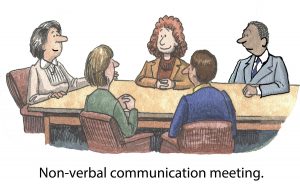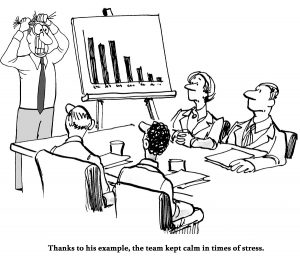Active listening leads to understanding

Have you ever been misunderstood? Felt like you were treated unfairly because of what you said? Remember a time where an argument broke out from what you thought was an innocent conversation.
It happens to everyone. And it happens because of a lack of listening. In fact, a failure to practice Active Listening is one of the largest causes of misunderstandings and arguments.
While we can’t control how others react or how well they listen, we can control ourselves. We can do our best to make sure that WE are not the cause of misunderstanding.
And that’s where the practice of Active Listening comes in. Apply these tips and you will have a good head start to be an Active Listening practitioner.
Open posture
Most of the time, our body obeys our mind. Whether consciously or unconsciously, our body will do what the mind tells it. We walk, we run, we touch, we hold. Mouth moves, sound comes out. All because of impulses from the mind sent to parts of the body.
There are times, however, when the mind will pay attention to the body. Feet pointed towards a door denotes a desire to escape. The mind picks up on that and says, “Hey, we are already late!” Off you go.
Arms and legs crossed give signals of protecting or shielding. Your mind senses danger, either physical or verbal, and goes into protection mode. It is basic non-verbal communication.
Active Listening Posture
Let’s turn it around. If you face the speaker with arms at your side or resting on a surface, you display openness. The mind picks up on those cues and therefore commands the rest of the body to pay attention. Even more so, the speaker’s mind will likely pick up on that as well. Tone and mood changes when the speaker perceives you are open to what they have to say.
Eye contact is your friend
The eyes, they say, are the window to the soul. That really stands out when you are engaged in conversation. Your eyes tell the speaker that you are anxious to hear what they have to say. Or they tell them you would much rather be anywhere but here.
When listening, your eyes should be open. Look at the speaker. You want to send the message that you are open and relaxed. Smile and your eyes and the rest of your face will follow suit.
But Not too much
On the other hand, be careful about making too much eye contact. Too much eye contact and you look like you are staring. Use the 70% guideline. Make eye contact with the speaker about 70% of the time. More than that and you look like you are staring.
Keep in mind, however, that the 70 rule is a general rule. A speaker who is introverted or not very sure of themselves may be actually put off by 70% eye contact. Note how the speaker reacts. If you are making eye contact and they look away, then you should look away too.
Undivided attention
Have you ever tried to have a conversation with someone while they are thumbing away on their smartphone? It’s annoying! You can’t really tell if they are paying attention or not. And if you bring it up, they try to tell you they can do that and listen at the same time. They are a great multitasker!
As we have mentioned before, multi-tasking doesn’t work . For anyone. If someone you are talking to tries to multi-task, you have a right to ask for their full attention or talk another time. If someone is speaking to you, you owe them the respect of your full, undivided attention. If you are unable to give it at the same, you owe them the privilege of getting it another time.
No Interruptions
 Email stays there until you look at it. Phones have voicemail. Let them be until you are done. Unless you have an urgent family matter pending, there should not be a reason to allow a speaker to be interrupted.
Email stays there until you look at it. Phones have voicemail. Let them be until you are done. Unless you have an urgent family matter pending, there should not be a reason to allow a speaker to be interrupted.
And YOU shouldn’t be the interruption either. Sometimes you will hear things you feel you need to react to right away. Don’t. What you want is to be able to respond, not react. Almost always when you react instead of respond things do not go well after that.
Don’t react. RESPOND.
And the time to respond is after the speaker has finished, not during. Don’t spend time trying to formulate your response while they are speaking either. You are spending time and space in your mind coming up with your response, which means you aren’t listening anymore. Stephen Coveyonce said, “Most people do not listen with the intent to understand, they listen with the intent to reply.” Is that true of you? Take some more advice from Covey. “Seek first to understand, then be understood.”
Affirm the speaker
Feedback is valuable. As John Maxwell says, “Feedback is currency for leaders.” It’s pretty much valuable currency for anyone. When you are engaged in a vital conversation, it’s important there too. While the other person is speaking, they will pause occasionally; sometimes to catch their breath, other times to gather their thoughts.
This is the perfect time to provide a quick affirmation. You want to let them know you are interested, that you are paying attention, and you want to hear more. You can learn a lot of phrases but the best response is a genuine response based on what they have said so far. “That’s interesting!” or “Tell me more.” or even “Really?!” It can even be as simple as a quick little “uh-huh” or “OK” or “yes“.
Keep in mind the objective is to encourage the speaker, not stop them in their tracks. Use language that is natural for you and don’t use the same one every time.
Question for clarity
When the speaker completes a thought, take the time to ask a question. Your objective here is seek understanding. So your question should require more than a yes or no response. You also want to take great care not to make your question a challenge or rebuttal. Look to fill in the blanks that may be left by what the speaker has said so far.
Tell them what they said
Once the speaker has finished it is the perfect time to respond. Start by repeating back what they said in your own words. “So what I hear you saying is…” and then repeat it. One of two things will happen. Either they will confirm your understanding or they will correct your understanding. Either way, it’s a win-win. They know that you actually paid attention and you know have a clear picture of what you are responding to.
Search the Feelings
Words have meaning. Part of that meaning is conveyed through the way that they are said. A study by Psychology Professor Albert Mehrabianonce discovered that WHAT WE SAY accounts for ONLY 7% of communication. The rest is handled by the WAY WE SAY IT and WHAT OTHERS SEE when we are saying it. So to really get meaning, we also have to get feeling. Listen and look for emotional content. A tone of voice, volume, and emphasis. And also
Look for Cues
 Body language also contains a good amount of context and content. Some say it is as large as 68% of meaning. A growing number of people are disagreeing with that. Whatever the number actually is, there is no denying that non-verbal communication is critical to your achieving understanding. Gestures, stance, and facial expressions all convey intent and emotion and meaning.
Body language also contains a good amount of context and content. Some say it is as large as 68% of meaning. A growing number of people are disagreeing with that. Whatever the number actually is, there is no denying that non-verbal communication is critical to your achieving understanding. Gestures, stance, and facial expressions all convey intent and emotion and meaning.
The more you pay attention to the whole picture in communication, the more meaning and understanding is gained. Communication actually occurs. That is practicing Active Listening.
Need help building excellent communications within your organization or team. Schedule a free Discovery Strategy Sessionwith me today to see how we can help you.




 According to
According to  As dire as the consequences are when we allow ourselves to react, choosing to respond can go 180 degrees in the other direction.
As dire as the consequences are when we allow ourselves to react, choosing to respond can go 180 degrees in the other direction.
 Email stays there until you look at it. Phones have voicemail. Let them be until you are done. Unless you have an urgent family matter pending, there should not be a reason to allow a speaker to be interrupted.
Email stays there until you look at it. Phones have voicemail. Let them be until you are done. Unless you have an urgent family matter pending, there should not be a reason to allow a speaker to be interrupted.  Body language also contains a good amount of context and content. Some say it is as large as 68% of meaning. A growing number of people are disagreeing with that. Whatever the number actually is, there is no denying that non-verbal communication is critical to your achieving understanding. Gestures, stance, and facial expressions all convey intent and emotion and meaning.
Body language also contains a good amount of context and content. Some say it is as large as 68% of meaning. A growing number of people are disagreeing with that. Whatever the number actually is, there is no denying that non-verbal communication is critical to your achieving understanding. Gestures, stance, and facial expressions all convey intent and emotion and meaning. 



 LEARN TO TRUST – start small by delegating out small tasks you would normally do to individual team members. Give them a deadline. Offer support. And let them have at it. I believe you will be surprised at the results.
LEARN TO TRUST – start small by delegating out small tasks you would normally do to individual team members. Give them a deadline. Offer support. And let them have at it. I believe you will be surprised at the results.